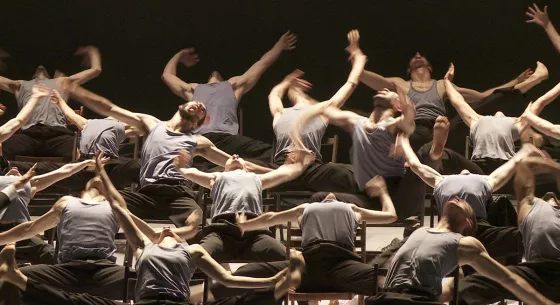Interview with Ian Robinson
What’s it like to be a dancer with the world-renowned Batsheva Dance Company? We caught up with dancer Ian Robinson to find out ahead of the company’s performance of Decadance 2017 on Jan 24!
First, a little about Ian: He graduated from New York University and performed with Mikhail Baryshnikov's Hell's Kitchen Dance, Complexions Contemporary Ballet, Les Ballets Jazz de Montreal, Sydney Dance Company, and Aszure Barton & Artists (who just graced our stage in November!). He joined Batsheva Dance Company in 2009.
Why do you dance?
Both of my parents were professional dancers and ran a dance school while I was growing up. I was immersed in dance from a very young age—studios, stages, music, lights, costumes. Alluring things for a kid with excess energy.
What do you do to get ready for a show?
We have a Gaga class before every show and then I just try to stay calm and warm before we begin.
What does a typical day in your life look like?
A regular day in Tel Aviv consists of class at 10:00 am, followed by rehearsals for whichever show we are creating or performing at the time. That finishes by 5:00 pm (in time to catch the sunset over the Mediterranean, conveniently visible from the studio windows). On tour we occasionally have time to explore the city we are in before we have to go to the theater for class and technical rehearsals. I like scouting out the best coffee spots in each place.
If you weren’t a dancer, what would you be?
It’s hard to say. Dance has led me to other passions like photography and video, which if I wasn’t a dancer, I’m not sure I would have found.
Who inspires you?
I can watch Rachael Osborne (a dancer in Batsheva Dance Company) for hours. [I enjoy] her creativity and unique physicality. In other fields, (astrophysicist) Neil deGrasse Tyson, (cinematographer) Emmanuel Lubezki, and (tennis player) Roger Federer.
What is life like with Batsheva Dance Company? What is it like working with/for Ohad Naharin?
A lot of what you can find on my Instagram account gives you an illustration of what life is like in the company, through my eyes. Photography is often a medium I’m more at ease communicating through. Working with Ohad has been extremely rewarding. He creates an atmosphere which allows the dancers to go beyond their familiar limits. In creation, he gives us tasks which we go about within specific boundaries he sets. [It’s] a bit like a game. We enter the studio as if (it’s) a playground.
What is your role(s) in Decadance 2017? Why is the piece so special/unique?
I do a few duets in the piece, but the show consists of mostly group sections, as does much of Ohad’s work. Decadance is a collage of parts from Ohad’s choreographies. He rearranges it differently every so often, and adds parts from new pieces as he creates them, so every show provides a unique experience.
What is your biggest challenge in performing Decadance 2017? What is your favorite moment in the show?
There is the sheer physical effort and the toll dance takes on your body, but the long-term and more interesting challenge is to keep the work fresh. We rehearse every show a lot, with repetition being an important part of the process. But that can create a kind of stale, “automatic pilot” mode which you can fall into when you are feeling tired or uninspired. To take something you know very well and to still find a way to connect to a sense you experience for the first time is the biggest challenge.
My favorite part to perform is the chair section of (the song) “Echad mi Yodea” because the music is just so good.
What is your favorite part of the dance creation process?
I like to create movement and also to learn movement from other people. I like to see how the movement we create fits into the tasks Ohad sets for us and how to allow the tasks to also inform our movement. Creation involves a lot of trial and error, but finally it is humbling to discover what works and what doesn’t in this way.
Where is the most beautiful place you’ve ever been?
Africa is beautiful, but I also love Australia.

